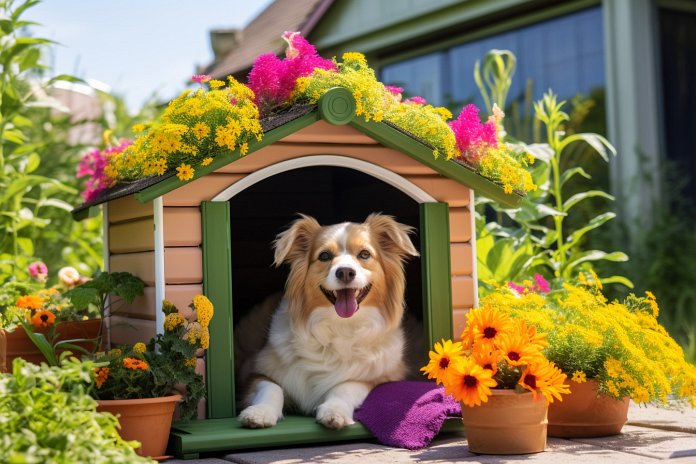
Have you ever wondered if dogs can live outside all year? The short answer is yes, but it’s not recommended. There are various factors to consider, but dogs who spend time indoors tend to be happier. Keeping dogs outside all year can lead to hazards, behavioral issues, and other problems. Dogs have psychological and genetic needs as pack and den animals. This article will discuss behavioral signs that your dog shouldn’t stay outside all the time and the reasons why.
Signs That Your Dog Shouldn’t Stay Outside All the Time
Dogs have psychological and emotional needs that can be negatively affected by being kept outside all year. If your dog shows signs of unhappiness, feeling unsafe, or unloved, it may not be suitable for them to stay outside all the time. Outdoor dogs often display behavioral issues such as stress, anxiety, noise-making, destruction, and attempts to escape. These signs indicate that your dog is not happy or secure being kept outside all the time. Difficulty in training is another sign of defiance against being outdoors. Outdoor dogs are harder to train and can be destructive.
Body Language
Your outdoor dog may be giving you subtle cues that they want to come inside. These cues include growling, barking, digging, whining, guarding, chewing, jumping up, howling, scratching, pacing, and sniffing.
Other Signs
Here are some additional signs that your dog may not want to be outside all the time: poor dog-to-dog behavior, less responsiveness to commands, running away or escaping the yard, behavioral issues, aggression, acting out, and difficulty in training.
The History of the Outside Dog
In the past, most dogs were kept outside all the time. However, studies have shown that dogs isolated in backyards develop behavior problems, poor psychological well-being, and higher rates of euthanasia. Outdoor dogs often lack strong bonds with their family, leading to stress and behavioral issues. They are also harder to train and less responsive.
The Science of Outdoor Dogs
Dogs are pack animals and need companionship. They also have den instincts and require a safe space for sleep. When dogs are kept outside all year, they miss out on forming relationships and find it difficult to find safety and security.
How to Train Your Outside Dog to Be an Inside Dog
Bringing your outside dog inside and turning them into a house dog may require some effort. Start with crate training to provide a safe space. Spend time with your dog during the transition and provide plenty of stimulation and attention. Give your dog toys, treats, and blankets to keep them occupied. Patience is key, as behavior change takes time. Use rewards and punishments to reinforce indoor-house rules.
“Bringing your outside dog inside can be a transition, but with love, patience, and discipline, your pup can become a happy house dog.”

Tips & Things to Know
1️⃣ Dogs are happier when they are not kept outside all year round. There are many hazards and behavioral issues that can arise from keeping a dog outside, including stress, anxiety, and destructive behavior. It is important to provide a safe and comfortable indoor environment for your dog.
2️⃣ Pay attention to your dog’s body language. If your dog is showing signs of stress or unhappiness, such as growling, barking, digging, whining, or chewing, it may be a clear indication that they do not want to be outside all the time. These behaviors can be a cry for attention and a sign that they need more love and companionship.
3️⃣ Training your outside dog to become an inside dog requires patience, love, and discipline. Start by crate training your dog to give them a safe and secure space indoors. Spend ample time with your dog during the transition, providing stimulation and attention. Have plenty of toys, treats, and blankets to keep them occupied. Remember to be patient and use reward-based training methods while also setting clear boundaries.
Frequently Asked Questions, Answered ✅
1. Can dogs live outside all year?
– The short answer is yes, but it is not recommended as there are many hazards and issues that can arise from keeping a dog outside all the time.
2. What are some behavioral issues that can result from keeping a dog outside all the time?
– Outdoor dogs may become stressed, anxious, and exhibit destructive behaviors such as barking, howling, chewing, and digging.
3. What are some signs that a dog doesn’t want to be outside all the time?
– Growling, barking, digging, whining, guarding, chewing, jumping up, howling, scratching, pacing, and sniffing are all signs that a dog may be indicating its discomfort with being outside all the time.
4. Why is it not recommended to keep dogs outside all the time?
– Dogs are social creatures that need companionship and a secure den-like space. Keeping them outside all the time can lead to poor psychological standing, behavior problems, and a lack of bonding with their owners.
5. How can you train an outside dog to become an inside dog?
– Crate training, spending ample time with the dog, providing stimulation and attention, and using positive reinforcement and appropriate punishments can help transition an outside dog to an inside dog.